"ThinkingJewellery" is an attempt to reflect on what jewellery is. It is about an interdisciplinary approach beyond the relevant categories of craft or art, applied or free: about exploring what jewellery is - not what it looks like. The need for adornment and jewellery has accompanied mankind as an anthropological constant from the very beginning. As an important cultural asset, jewellery is constantly reinterpreted in all eras. ThinkingJewellery brings together analyses and perspectives for action that are relevant to artistic practice.
Can the arts be satisfied with a role as a supplier of consumer goods on the cultural industry market? Or is it time to focus more on the political implications of art in order to deal more proactively with contemporary social issues?
At the beginning of the 20th century, when the industrial revolution had unhinged the old world, the response of modern art was a socio-politically understood programme for the reconciliation of science, technology and society through art.
Since the 1970s, this programme has been considered a failure. The unleashed economy of the post-industrial age and globalization have brought the earth to the brink of ecological collapse and exacerbated social injustice. At the same time, the late effects of colonization and the digital revolution have posed new cultural and political challenges. More profound changes are ahead than those of the industrial revolution.
ThinkingJewellery XII gathers - with jewellery in mind - exemplary analyses and discusses perspectives for action under the aspect of political premises.
Program:
(NOTE: Lecture of approx. 2,5 hrs in German/
HINWEIS: Vortrag von ca. 2,5 Stunden in deutscher Sprache)
“See through your life, your life is a scheme
Pressed by TV and these magazines
I look at you and you look at me
What are you trying to be?
Dein Sacko sitzt so sackgerecht
Dein Herz passt auf den rechten Fleck
Yes, we are made in Germany
Nur sauber gekämmt sind wir wirklich frei
Nur sauber gekämmt sind wir wirklich frei
Nur sauber gekämmt sind wir
Wirklich frei“
Ausschnitt Songtext «Man of Stone», Hans-A-Plast, 1979
Schmuck als Manifest einer Haltung ist allein im Kontext seiner Zeit zu verstehen.
In Zentren urbaner Subkulturen des Westens zeichnete sich seit den späten 1970er Jahren ein grundlegender Paradigmenwechsel ab, der sich einer völlig neuen Ästhetik als Ausdrucksmittel bediente. Einem saturierten, dekadenten und repressiven Establishment begegnete man mit einer neuen Sprache. Wütend und lustvoll, sarkastisch und zynisch erscheint sie in Bildender Kunst, Musik, Tanz, Mode und Lebensstil: Eine Revolte gegen Rassismus, Faschismus, Imperialismus und Krieg, antiautoritär, feministisch, anarchisch.
Bernhard Schobinger
geboren 1946 in Zürich, Schweiz,
1962 Kunstgewerbeschule Zürich,
1963 Goldschmiedelehre,
1968 eigene Goldschmiedewerkstatt in Richterswil,
zahlreiche Ausstellungen, Preise, Vorträge und Workshops weltweit.
www.schobinger.ch/about/bernhard-schobinger
"Jewellery - materialised traces of social interaction"
JULIA WILD M.A.
Jewellery is a social code that triggers something in the wearer as well as in the observer: it can be read, generate approval, but also cause irritation. Jewellery causes us to judge the person wearing it, to classify them in our "worldview". As social beings, we react consciously or unconsciously to these signs, enjoy them, are fascinated by them or reject them, perceive them as inappropriate. They are signs that position the wearer of jewellery as well as the viewer in a social space and are thus politically effective.
Human interaction is subject to an ongoing process of balancing, negotiating and representing positions. An important function of jewellery is to make these processes and the underlying changes visible. In this process, the two poles within this negotiation process materialise in jewellery, namely the connecting as well as the distinctive element. Jewellery makes these accessible and tangible. Through the materiality of jewellery, people can relate to its inherent connecting or distinctive value in visible symbolic acts, by wearing it, by appreciating it in others, by guarding it or by referring to it in their actions, or by changing it, destroying it, forgetting it. By using jewellery as a code, it is not only access to a transcendental world of ideas, but also a form of expression of our social and thus also political will to shape things.
Julia Wild
Born in 1970, has been a research assistant in the Department of Gemstones and Jewellery at the Trier University of Applied Sciences since 2010. She studied history and literature at the Ruprecht-Karl University Heidelberg. Her interests lies in the social functions of jewellery. In particular its role within the symbolic communication of humankind: the actors, their physical and psychological appearance, action and mutual perception as well as the context, consisting of culture, environment and space, in which an interaction with jewellery takes place. This results in her questioning the way in which social and environmental matters influence the appearance of jewellery throughout history.
Material structures society and nature in relation to one another. It is both a driver of innovation and a driver of destruction. The extraction of raw materials transforms nature into a commodity and forces the exploitation of natural resources as well as people. In parallel, the appropriation of material generates cultural phenomena such as money, tools, weapons, jewellery and objects; economic processes such as trade and commodities. Meanwhile, the exploitation of materials for mass consumption has led to the great ecological crisis. Precious and rare materials have been used to create decorative objects of all kinds that incorporate and represent social and political hierarchies such as control and domination. In the lecture, various jewelley objects from the collections of the Museum of Decorative Arts in Berlin, ranging from the Wunderkammer to the present, will be examined for the first time for their narratives in the context of the "Matrix material-power".
Claudia Banz
born 1966, is an art historian, exhibition curator and author and currently curator of design at the Kunstgewerbemuseum, Staatliche Museen zu Berlin Preussischer Kulturbesitz. Previously, she was head of the Department of Art and Design at the Museum für Kunst und Gewerbe in Hamburg. With exhibitions like Fast Fashion. The Dark Side of Fashion, Food Revolution 5.0. Design for Tomorrow's Society or Connecting Afro Futures. Fashion x Hair x Design she focuses on sustainability, resources, responsibility, consumption and decolonial design. Her new series "Design Lab" at the Kunstgewerbemuseum presents current positions in the global design discourse. Banz also researches and publishes on/at the interfaces of design, craftsmanship, fashion, art and decolonial collections.
"Jewellery and Politics - Notes on the History of Jewellery in Germany"
WILHELM LINDEMANN
Jewellery is usually associated with a beauty that self-referentially serves only itself. In reality, the stark opposite is the case: it is not only an index of social status that reveals a lot about its wearers. From antiquity to the present, it has been a sign of power and wealth, and precious metals and gemstones are still the preferred materials of jewellery. On the one hand, the lecture refers to the political aspects of German jewellery history in the 20th century, especially before and during the period of National Socialism; on the other hand, it reaches beyond this epoch and refers to current as well as general ethical and also ecological issues.
Wilhelm Lindemann
Born in 1949, after studying philosophy, literature and social work, he worked in cultural management for many years. Producer of plays, festival director and project developer of the Bengel industrial monument, Idar-Oberstein. Long-time lecturer at the Department of Gemstones and Jewellery, Idar-Oberstein, curator of SchmuckDenken and exhibitions, author and publisher of non-fiction books on jewellery and gemstones.
"pecunia expergisci debet"
PIETER LEMMENS
From a strong social and societal engagement, Pieter Lemmens plays with the relations between art and power in his work and expresses relevant themes of the time. As a witness to his own time, he feels drawn to comment on it in a creative, playful and ironic, but also serious way. Within his umbrella theme, his imaginary company Q P & S, Lemmens creates his views on what is happening in the (art) world when it comes to the dynamics and organisation within the various networks of production, participation, reception and distribution. To this end he pulls out all the stops and, although the aesthetic results of each work are surprisingly different, his own handwriting remains visible, both literally and figuratively. (P. Snoeks)
Pieter Lemmens
(*1965) artist, autodidact.
www.pieterlemmens.nl
"When Art wants - a personal view on political art"
PROF. EVA-MARIA KOLLISCHAN
Being an artist means being a political person, no matter what the artistic work is about. Visual art has a special relationship with our society and history. Art is at the same time a part of society and takes a look at it from the outside. A work of art is something different from a protest or a political action. What can art do, what does it want? What if art wants nothing? This lecture takes a look back at some historical positions in political art and gives a reflection on being an artist in a time like ours, with circumstances that more and more require us to take a clear position and get involved.
Eva-Maria Kollischan
is visual artist, born in Nuremberg, based in Cologne and Idar-Oberstein. She studied fine arts at Kunstakademie Münster. Within site specific installation, drawing, painting and photography she is exploring the limits and properties of our perception and spatial imagination. She has been teaching art basics and drawing at Goethe-Universität Frankfurt am Main, Hochschule der Künste Bremen and others. Since 2014 she is teaching art basics at TUAS, Department for Gemstones and Jewellery.
"Prints and Politics"
DR. DORIT SCHÄFER
Prints, because of their reproducibility, play a prominent role in the theme of art and politics. Since the emergence of printmaking in the 15th century, it has been used by artists and rulers to make political statements - as commissioned art by those in power to secure their positions or as resistance by the governed to oppression and injustice. Unlike any other medium, thousands of prints of an artistically worked woodblock, copper plate or litho stone on light, mobile and inexpensive paper allowed the dissemination of theses and motifs that were politically highly explosive. In addition, printmaking offered artists a creative freedom in a wide variety of techniques that inspired them to innovative, sometimes decidedly provocative formulations. Through selected examples from six centuries, the lecture will discuss the history and significance of a medium in which free art and political motivation enter into extraordinary dialogues.
Dr. Dorit Schäfer
studied art history, classical archaeology and French literature in Heidelberg and London. Doctorate in 1998: The Ortenberg Altar - Studies of Middle Rhine Art and Painting Technique around 1400. 1998 - present at the Staatliche Kunsthalle Karlsruhe, where she became head of the Kupferstichkabinett in 2003. Main focus of work in French art of the 18th-20th century and in contemporary drawing and prints. Among the exhibitions at the Staatliche Kunsthalle Karlsruhe, which she curated or in which she collaborated, are worthy of special mention: Jean Siméon Chardin 1699-1779. Werk – Herkunft – Wirkung (1999); J.J. Grandville. Karikatur und Zeichnung (2000); Eugène Delacroix (2003); Stefano delle Bella. Ein Meister der Barockradierung (2005); Picasso, Matisse, Chagall… Französische Druckgrafik 1900-1950 (2006); Kräftespiel – Zeichnung und Grafik von Thomas Meier-Castel (2008); Camille Corot – Natur und Traum (2012); Ich bin hier! Von Rembrandt zum Selfie (2015); SEHEN DENKEN TRÄUMEN. Französische Zeichnungen aus der Staatlichen Kunsthalle Karlsruhe (2018/19); Alles ist Ausschnitt! Matthias Mansen: Potsdamer Straße (2019); Marcel van Eeden - The Karlsruhe Sketchbook (2019)
"Identity Markers"
DAVID BIELANDER
Swiss born, Munich based artist David Bielander takes the familiarity of everyday objects and combines them with a witty abstraction to create truly uncanny artworks. His realm of inquiry encompasses the play of identity, belonging, dissonance, external perceptions and the opinions they create. More than ever actually, he is specifically preoccupied, aware and excited about the potential of these humble objects in connection with us.
Bielander doesn’t work in themes or phases. All his works are one oeuvre, one continuously growing single body of work, intertwined, connected and slowly shifting. So previously created works make astounding evolutions. What does it now mean to mimic an animal or a flower in this dystopian reality? Who are we sticking our tongue out at with the iconic rubber lip from 1999? And how does it interact with the 2019 pinocchio nose, carved from the wood of a confessional?
David Bielander
Born in 1968 in Basel. After a four-year apprenticeship as a goldsmith with Kurt Degen, and working as a goldsmith with Georg Spreng in Schwäbisch Gmünd, he studied at the Academy of Fine Arts in Munich from 1995 to 2001 with Prof. Otto Künzli, where he graduated as a „meister" student in 2002. From 2006 to 2010 David Bielander was an artistic assistant to Prof. Daniel Kruger at Burg Giebichenstein, University of Art and Design, Halle/Saale, and from 2011 to 2013 an external tutor in the jewellery department, Gerrit Rietveld Academie Amsterdam (NL). Since 2002 he runs a studio in Munich together with the artist Helen Britton, Australia, and Yutaka Minegishi from Tokyo. His work is represented by the galleries S O in Solothurn and London, Ornamentum Gallery in Hudson, NY, Rob Koudijs in Amsterdam, Galerie Funaki in Melbourne, Antonella Villanova in Florence, ATTA gallery Bangkok and Galerie Wittenbrink in Munich.
"painting space"
TAMINA AMADYAR
Amadyar's colour is there in extreme clarity, simple, immediate. It stands openly on the bare canvas. Radiantly light, almost floating, the colours transcend their material bondage. They glisten into each other, lift, fade through or arch over each other. Between intimacy and intensity, colour alone carries the pictorial fields in settlement and opposition, turmoil and balance, depicting memories of a youth in Afghanistan.
Colour and light unfold a sensuality that points perceptibly beyond the pictures. Only what does Tamina Amadyar bring into the presence? She paints from memory. And in her pictures - hidden in the colour and at the same time revealed by it - places, inconspicuous everyday situations or entire landscapes actually appear as colourful moods, sensations and hunches. A horizon of experience that makes Tamina Amadyar's painting an enormous resonance space.
Tamina Amadyar
born 1989 in Kabul, studied painting at the Düsseldorf Art Academy. Group exhibitions at KIT - Kunst im Tunnel (2011), Contemporary Fine Arts (2015), Eduardo Secci Contemporary (2016), solo exhibitions at Guido W. Baudach (2015), Farbvision (2016). In 2016 she was elected to the Forbes "30 under 30" list.
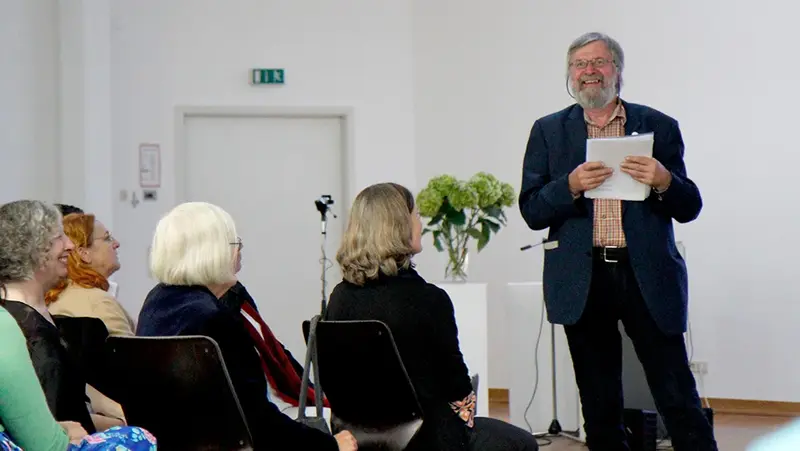
Imagination and virtual worlds
Beyond its value of utility , noble material - gold, silver, noble stones - has a lasting existence above all because of its symbolic power. In the field of jewellery, the classic range of materials has been expanded to include many natural materials and plastics that can be recharged. In jewellery, too, art, the old master of fiction, utopian design and thus virtuality, outlasts time: Ars longa - vita brevis.
Meanwhile, it is not only physics that has long since abandoned the traditional notions of "solid" matter in dynamic cosmological models. The digital age is revolutionizing people's living conditions and, in particular, their social relations - probably to a greater extent than the invention of book printing at the beginning of the modern era.
Virtuality does not require proof of authenticity, nor real correspondence between material, form and colour. In view of these scenarios, which are also omnipresent, a longing for the authenticity of analog life, for a permanence and value grows, which materializes in the material and thus sensual presence of high-quality, identity-creating goods or in art.
Program:
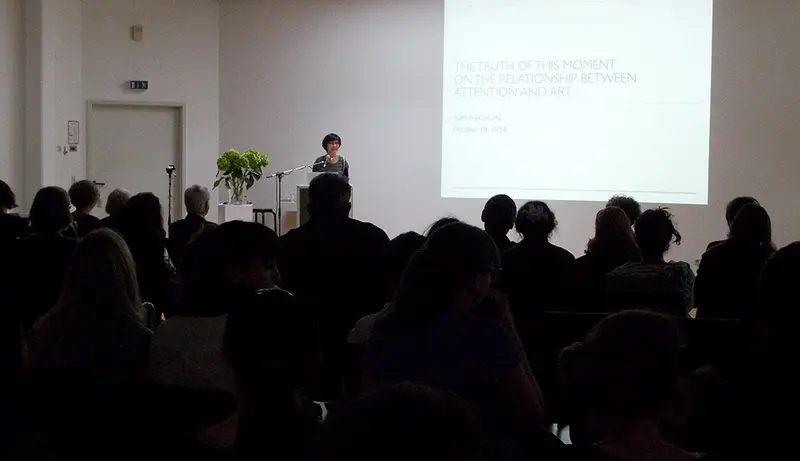
The process of globalisation in all areas of life, accompanied by the escalation of economic and ecological crises, technological innovations taking place in ever faster succession, a hardly manageable supply of information and communication have led to a growing need for leisure and contemplation on the part of many people - in addition to a feeling of being overtaxed. They are regarded by many people as a source of a regained art of living. The contemplative life design opens the senses for aesthetic experience and creativity. For some it has become the gateway to a new spirituality.
ThinkingJewellery X puts the contemplative concept of life to the test. Does it lead to a retreat into the private sphere and a rejection of social responsibility - or can it become a source of strength for creativity and worldliness in the sense of an argument for a peaceful policy based on mindfulness and sustainability?
Programm:
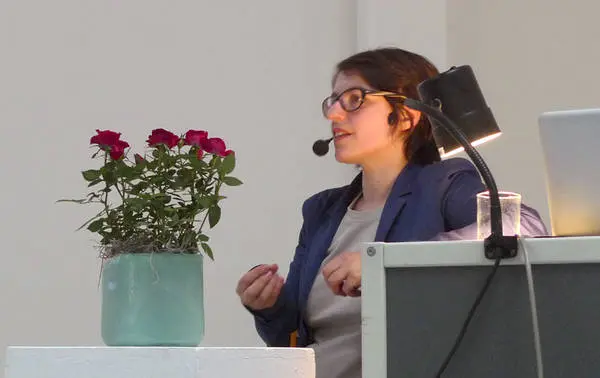
The need for adornment and jewellery has accompanied mankind as an anthropological constant from the very beginning. As an important cultural asset, jewellery is reinterpreted time and again in all eras. The age of postmodernism is for many an apocalyptic complex of crises: ecological crisis, financial crisis, crisis of justice. In the age of globalization and social division, politics increasingly appears to be incapable of action, despite all the conjurations of the lack of alternatives to one's own actions. At the same time - not only in fashion or advertising - a new regime of the aestheticization of everyday life is emerging, at the end of which the self-presentation of the individual in the net takes the place of real relationships. SchmuckDenken 9 gathers - under consideration of jewellery - exemplary analyses and discusses perspectives for action under the aspect of ethical premises.
Program:
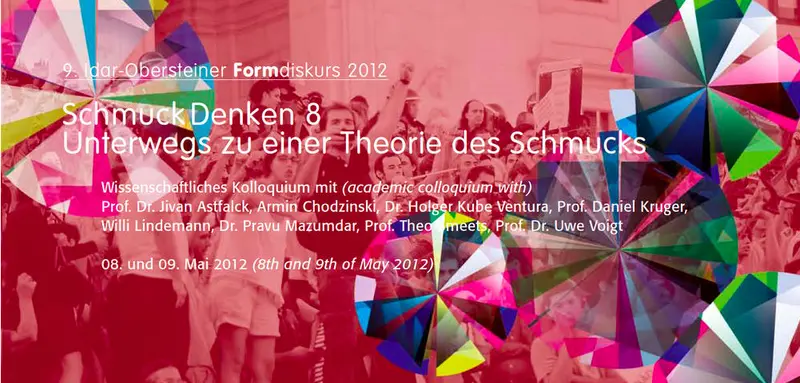
The 8th edition of ThinkingJewellery critically deals with the responsibility of art in a world that is endangered by the human being and the ideology of unlimited growth. Once again, it is focussed on the role of the jewellery artist within the society and his responsibility. Besides this ethical question it also deals with the question if art and aesthetic experience will promote the process of the scientific perception and interpretation of the world and which role the traditional materials of jewellery art, gold and gemstones play or can possibly play within this context.
Programme:
Prologue
Prof. Theo Smeets, Trier University of Applied Sciences, Dept. of Gemstone and Jewellery Design, Idar-Obertein, DE
Thinking Materials – Forming Ideas
Prof. Dr. Jivan Astfalck, Director of School of Jewellery, Birmingham Institute of Arts and Design, Birmingham City University, Brimingham, UK
About the metaphor of growth – tour through an exhibition project
Dr. Holger Kube Ventura, Director of the Kunstverein Frankfurt/Main, DE
About the metaphor of growth – performance
Armin Chodzinski, Performance Artist) Hamburg, DE
The near mirror – Philosophy and Art in the 20th century
Prof. Dr. Uwe Voigt, Philosopher, Professor for Analytical Philosophy and Philosophy of Science, University Augsburg, DE
The double gold. The birth of money from the spirit of jewellery.
Dr. Pravu Mazumdar, Philosopher, Munich, DE
On the iconography of gemstones
Wilhelm Lindemann, Curator of the city of Idar-Oberstein, DE
Daniel Kruger: Vita and Work
Prof. Daniel Kruger, Professor for Jewellery Design, HdK Burg Giebichenstein, Halle, DE
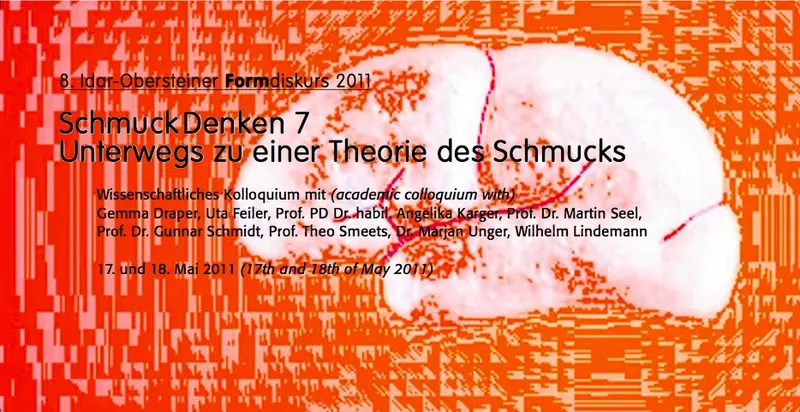
The 7th ‘SchmuckDenken’ will strike a balance between the symposia to date and identify the initial contours of a theory of jewellery.
At the same time, possible parameters for strategies for action for an autonomous creative practice of applied art in the conflicting demands of craft, design and fine art will be developed. As a result, the focus this year will be on the artistic identity of jewellery creators and their social role and responsibility.
A book ‘ThinkingJewellery - A theory of jewellery’ will be published by the ARNOLDSCHE Verlagsanstalt Stuttgart to mark the 7th colloquium. The book includes a selection of articles from the years 2005-2010 and also contains around 100 illustrations of works of students and graduates which provide an appraisal of the current situation of the field of study of Precious Stone and Jewellery Design.
Programme:
Prologue, 'Thinking Jewellery 2005-2011: On the way to developing a theory of jewellery’
Wilhelm Lindemann, chairman, Idar-Oberstein, DE
The masquerades of identity – on the costume art of Leigh Bowery
Prof. Dr. Gunnar Schmidt, Professor of Theory and Practice of Intermedia Design at the Trier University of Applied Sciences, Trier,. DE
Jewellery artist in the GDR
Uta Feiler, Jewellery artist, Erfurt, DE
Jewellery in context
Dr. Marjan Unger, art historian and publicist Bussum, NL
Impact of Signs and Design Ethics
Prof. PD Dr. habil. Angelika Karger, Professor of design theory, University of applied Sciences, Schwäbisch Gmünd, DE, and assistant professor of sciences, University Stuttgart, DE
Applied uncertainty, a doubt in process
Gemma Draper, Jewellery artist, Barcelona, ES
The jewellery of beauty and the beauty of jewellery
Prof. Dr. Martin Seel, Professor of Philosophy at the Johann Wolfgang Goethe-University, Frankfurt/Main, DE.
Modern tool or ancient medicine? Thoughts on being a jeweller
Prof. Theo Smeets, Professor of Jewellery Design, Department of Gemstones and Jewellery, Trier University of Applied Sciences, Idar-Oberstein, DE
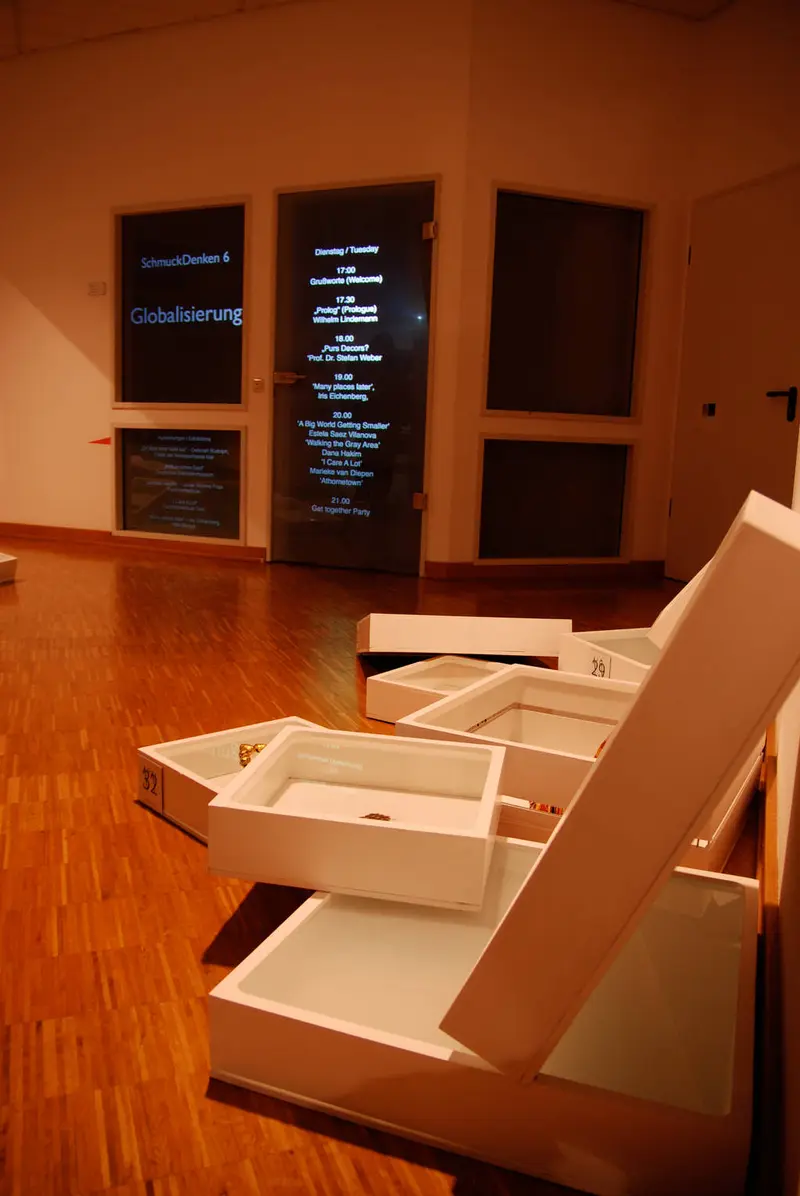
This year the 6th colloquium deals with the all-embracing tendencies
towards globalization, which operate at every level – economic, political and cultural. The focus is on the cultural and artistic global interdependencies of the past and present and also considers their effects on jewellery. In the process, the theme will be exemplified in detail, taking art in the Islamic world as an example.
Program:
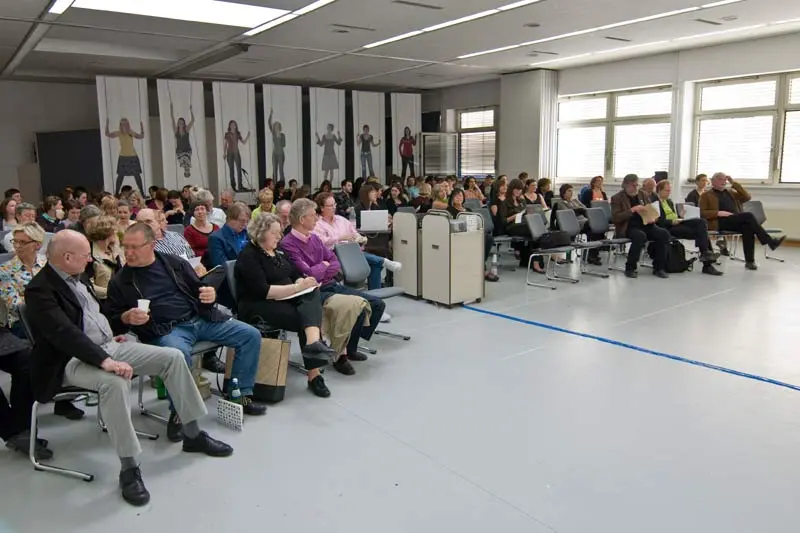
‘Schmuck-Denken 2009’ places the focus on jewellery as an object. Jewellery can be many things: It definitely comes under the category of loved objects (Habermas), with which their owner develops a very personal relationship. As a personal object which is a part of the character of its wearer, it supports him or her in their self-development and the profiling of their personality, both internally and externally. Sometimes jewellery becomes a fetish, thereby even acquiring its own power to act. At all events, jewellery can be described as an attribute. Jewellery in the sense of an attribute raises the question of identification. Marjan Unger reflects the theories of Allison Lurie when she writes: ‘I don’t wish to place too much emphasis on the point that ‘jewellery’ behaves like ‘language’, but rather that it contains a language. The vocabulary would be the types of jewellery, supplemented by the symbolism of the forms, colours, motifs and any other references. The grammar would be how and when jewellery is worn and also who owns what pieces and who does not. In short: how people interact with jewellery.’
Programme:
Prologue
Wilhelm Lindemann, Chairman, Idar-Oberstein, DE
On the product-aesthetic education of human beings
Prof. Dr. Wolfgang Ullrich, professor of art history and media theory at the University of Arts and Design, Karlsruhe, DE
West African fetish cult and European fetishism’)
Prof. Dr. Karl-Heinz Kohl, professor at the Institute for Historical Ethnology, Johann Wolfgang Goethe University, Frankfurt, DE
Assignments – post from heaven
Truike Verdegaal, Jewellery Artist, Amsterdam, NL
Diamonds are a girl's best friend – on the psychology of jewellery
Prof. Dr. Tilmann Habermas, professor at the Institute for Psychology, area of study psychoanalysis, at the Johann Wolfgang Goethe University, Frankfurt/Main, DE
The magic object in modernity. An anthropological con- stant?
Dr. Viola Altrichter, cultural sociologist, Berlin, DE
Reading jewellery
Drs. Liesbeth den Besten MA, Art Historian, Chairwoman of the Françoise van den Bosch Foundation, Amsterdam, NL
Temptation“ (English)
Drs. Marjan Unger, Art Historian and Publicist, Bussum, NL
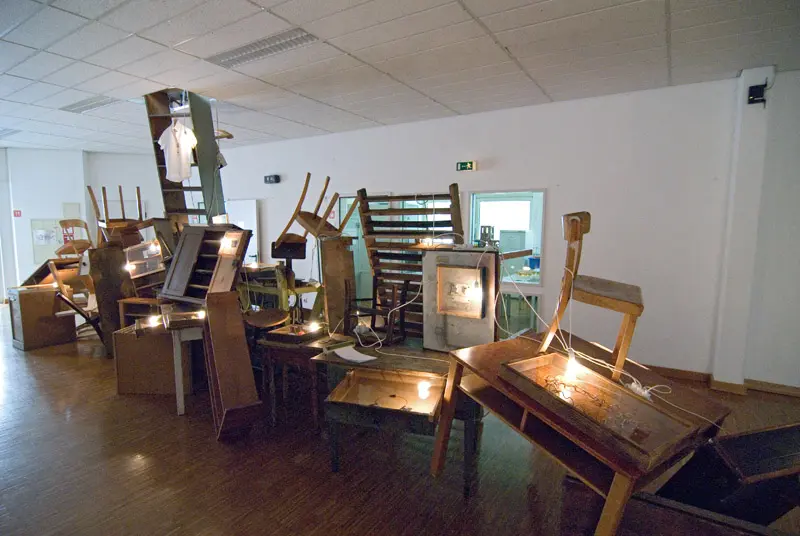
In 2008, our 4th Symposium is dedicated to the ornament. Is jewellery per se decorating? Are there contemporary ornamental means of expression? What is their social context? Scientist and artists are discussing these controversial questions about the influences of the ornament on jewellery and society.
Programme:
Prologue
Wilhelm Lindemann, Chairman, Idar-Oberstein, DE
especially bananas: the ornament according to Adolf Loos or the evolution of culture
Dr. Christina Threuter, Art Sciencist, Trier University, DE
Gijs Bakker and the ornament
Gijs Bakker, Designer, Amsterdam, NL
Beuys’ social sculptures)
Johannes Stüttgen, Artist, Düsseldorf
a critical theory on ornament
Prof. Dr. Burghard Schmidt, professor of language and aesthetics – University of Art, Offenbach, DE
“since beauty is nothing but the beginning of the terrifying“ (Rilke) – Notes on symmetry and the breaking of symmetry in cognition and aesthetics
Prof. Dr. Helmut Neunzert, em. Professor of Mathematics, Technical University Kaiserslautern, Kaiserslautern, DE, Fraunhofer ITWM, Kaiserslautern, DE
“those nice manners in fact ruin the beautiful melody“ Ornamentals and style in 18th century music
Prof. Reinhard Bahr, Professor for Ornamentation at the University of Music and Theatre Hamburg, DE
is jewellery art?)
Peter Egli, artist and author, Bern, CH
Jewellery. To be
Lin Cheung, artist, London, UK
My longing for the market of Samarkand
Marjan Unger, art historician, Sandberg-Institut, Amsterdam, NL
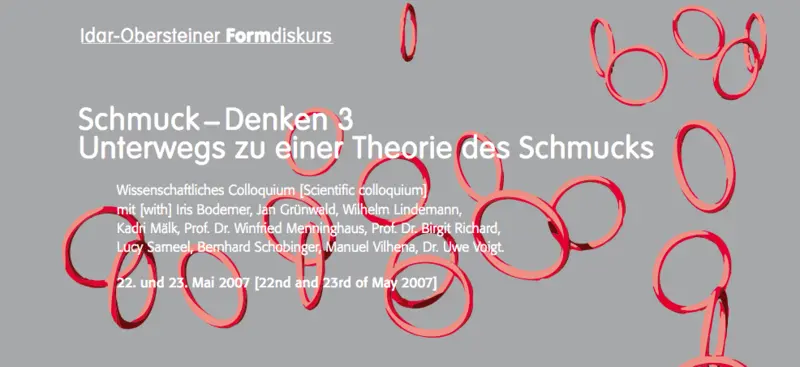
The 3rd colloquium “Schmuck-Denken” 2007 is still in search of a jewellery theory with the focus on the complex relationship between beauty and uniformity. As an element of pursuing acceptance, jewellery can become a tool of conformity. It also can become an instrument of non-conformity when it is used as a provocative attempt to separate oneself from society. On the other hand, it is conformist, in the case of the jewellery demonstrating an affiliation to a sub-cultural group.
Program
The colloquium "ThinkingJewellery 2" focuses on the artistic and art theoretical discourse on jewellery. The starting point of the debate will be contributions by conceptually working artists. Their positions will be supplemented and deepened by theoretical contributions. This is an attempt to formulate the initial question about the nature of jewellery in concrete terms and to provide exemplary answers.
Programme:
Prologue
Willi Lindemann, chairman, Idar-Oberstein. DE
An object oft beauty
Suska Mackert, artist, Amsterdam, NL, and Berlin, DE
on adornment
Manfred Nisslmüller, artist, Wien
Lifelines
Jivan Astfalck, artist, Senior Research Fellow and MA course director, School of Jewellery, Birmingham, UK
Body - Limb - Jewellery
Willi Lindemann, chairman, Idar-Oberstein. DE
Schmuck im Aufbruch: Schnittstellen in der Begegnung von Schmuck und Kunst im 20. Jahrhundert
Dr. Ellen Mauerer-Zilioli, Art historian and gallery owner, Desenzano de Garda, IT
Man and the natural environment: sociological approach to the temporalities of stone
Emmanuel Gleyze, sociologist, Université Paul Valérie, Montpellier, FR
Hinter Glas – Schmuck als musealer Gegenstand
Dr. Cornelie Holzach, Art historian and director of the Pforzheim Jewellery Museum, Pforzheim, DE
Behind the at first glance somewhat strange sounding title "ThinkingJewellery" is an attempt to reflect on what jewellery is.
What seems particularly disconcerting is the idea of trying to grasp such a sensual matter in a mental, i.e. non-sensual way.It is about an interdisciplinary approach beyond the relevant categories of craft or art, applied or free: about exploring what makes jewellery - not what it looks like.It is easy to see that the answer to this question is not easily given: neither would it be a satisfactory answer that it is the task of jewellery to decorate - this would be a mere tautology. Even though the formal language of the jewellery can be quite artistic, it is still a self-referential work of art in the true sense of the word. Perhaps jewelry should rather be described as a special kind of personal objects that have a special relationship to the bodies and personalities of the wearers of jewelry. In 2005 poses the question of the nature of jewelry - not from the perspective of jewelry designers or art history.
This year's colloquium brings together ethnologists, philosophers, artists, natural and cultural scientists for a first look at the "beloved objects", quasi from outside.
Programme:
You are leaving the official website of Trier University of Applied Sciences